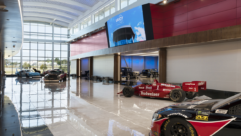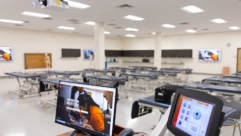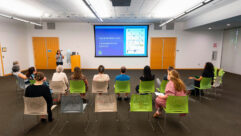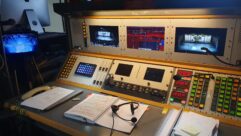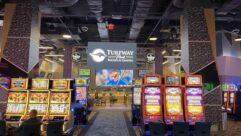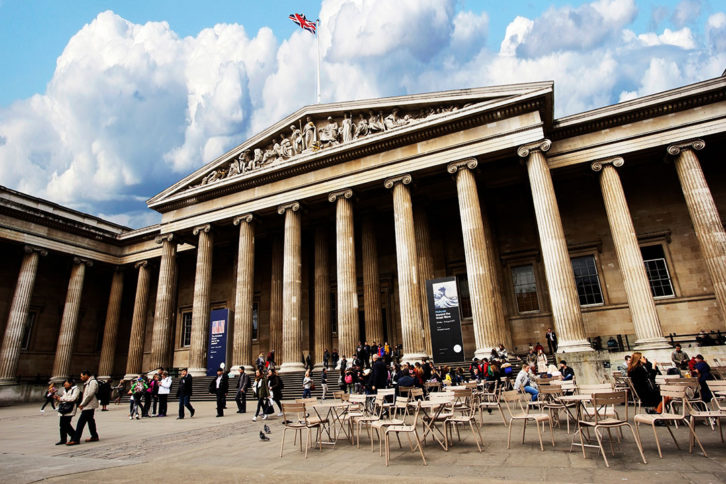
Over two hundred and fifty years ago, the first national public museum in the world opened its doors. Truly an exercise in astonishing facts and figures, since that time the British Museum has cared for more than eight million works of art, historical artefacts, and archaeological finds. British Museum Exhibitions must be displayed to their full potential, and the full museum experience must be seamless for all guests. This goal is difficult to achieve with non-standardized equipment and systems.
To tackle the challenge, the British Museum team selected systems integrator and production company Autograph Sound to update the control system for exhibition audio and video content. Autograph’s long experience with QSC led them to propose Q-SYS as the audio, video and control solution to providing consistent incoming exhibition experiences. With QSC, Autograph Sound started toward building a standardized and modular control architecture facilitated by easy and immediate control access.
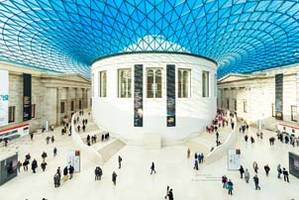 “We know Q-SYS inside out as we’ve used it for so many things. It was the ideal solution here,” explains Euan Mackenzie, Business Development Lead of Autograph Sound. “Our engineer handled all the custom programming for the Museum and now the two spaces — the Sainsbury Exhibitions Gallery and the Joseph Hotung Great Court Gallery — have their audio, visual and control by Q-SYS. It runs audio while managing projectors, media players, video playback, and PCs via dedicated portable user interfaces. And best of all, the Museum’s AV team have been left with a design they can reconfigure to suit their needs, in a language that is easy to understand.”
“We know Q-SYS inside out as we’ve used it for so many things. It was the ideal solution here,” explains Euan Mackenzie, Business Development Lead of Autograph Sound. “Our engineer handled all the custom programming for the Museum and now the two spaces — the Sainsbury Exhibitions Gallery and the Joseph Hotung Great Court Gallery — have their audio, visual and control by Q-SYS. It runs audio while managing projectors, media players, video playback, and PCs via dedicated portable user interfaces. And best of all, the Museum’s AV team have been left with a design they can reconfigure to suit their needs, in a language that is easy to understand.”
The nerve center of the Sainsbury Gallery is a Q-SYS Core 110f processor handling all I/O, routing, and DSP across audio, video, and control applications. To accommodate a greater array of audio formats, Autograph took advantage of the Software-based Dante™ compatibility of the Q-SYS Core 110f, adding a PoE audio converter and interface to convert sixteen analogue inputs to the Dante Audio-over-IP networking standard. This massive expansion enables the in-house AV team to better manage the vast diversity of incoming exhibition designs. The Joseph Hotung Gallery was fitted with a Q-SYS Core 8 Flex processor, the compact yet powerful sibling of the Q-SYS Core 110f, as well as the eight-inch display Q-SYS TSC Series Gen 2 touch screen controller, which allows for simple and straightforward graphical control of all operations in this space.
But control access is not limited to the Q-SYS touchscreen controller. For museum personnel who interact with the public and run exhibits, access must be easy and immediate. “The Visitor Services department is very much the end user of the system,” says Clark Henry-Brown, A/V Team Lead at the British Museum. “The open-ended structure of Q-SYS let us design a separate iPad user interface for them, which allows them to troubleshoot any problems before escalating to the audio-visual team. If an event or filming is occurring in an exhibition space, they can even mute specific media points, again saving a call to us. Every little bit helps.”
Access by multiple teams was also a must, as Henry-Brown elaborates. “There’s a very much multi-faceted experience for users of our Q-SYS system for exhibitions, best explained cross-departmentally,” he says. “During the fit-up phase of exhibitions, Q-SYS is used as a playback system for audio and does all our speaker processing. Because we house our show equipment in server rooms, there’s a necessity to be able to mix remotely in the exhibition space, which Q-SYS allows. Also, to have full control of exhibition hardware and be able to mix on the fly as we review everything with the exhibition design team is great. Our previous system did not allow this.”
Henry-Brown surmises that the new Q-SYS install has enriched the already elevated experience offered by the British Museum. “We’ve not had an issue since installing the system and in regard to the visitor experience, there’s minimal downtime.” he praises. “Everything sounds much better, due to being able to prepare a design months before the exhibition fit-up and then mix within the space — and the fact that Q-SYS optimizes all the loudspeakers.”
Employees are continually working behind the scenes to deliver experiences which will shape millions of lives. The British Museum’s legacy is one that few institutions can rival, and countless hours go into maintaining its standards. The audio-visual department and broader staff work in a symphony of effort to this end, and QSC is now proud to be a part of the team.


